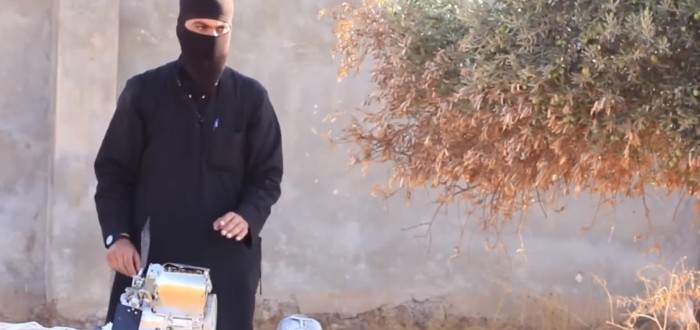Kenton Fulmer
Unexploded Russian and Soviet-made submunitions have been documented across the Syrian countryside since the arrival of Russian forces last month. While both the intended destructive impact and prolonged danger of unexploded ordnance (UXO) are well understood results of cluster munitions use, a lesser seen impact is the re-purposing of munitions that have failed to function on a large scale, contributing to a prolonging of conflict. A video produced by Jabhat al-Nusra (shown below) and uploaded 15 October 2015 shows the disassembly of the SPBE and AO-2.5RT submunitions.
The militant in the video gives a brief explanation of how the SPBE submunition works, outlining the basic components of the munition and using clips from an animated explanatory video from the munition’s manufacturer. While the disassembly procedures cannot be assessed for safety, the methodology used by the militant demonstrates a distinct level of understanding of the munition beyond what may be typically expected. He also specifically indicates that the large number of unexploded munitions of this are the primary reason for producing the video. This may be a standardised al-Nusra effort to demonstrate EOD capability for disarming and re-purposing UXO into improvised explosive devices (IED). The re-purposing of explosively-formed projectiles (EFP) from SPBE submunitions is of particular concern.
The recent expansion of the air campaign by Syrian government and Russian forces has resulted in a significant expansion of the quantities of conventional air-delivered ordnance being employed in Syria. Russia has been quick to demonstrate to the world its combined arms capability using long range naval cruise missiles, precision guided bombs, advanced submunitions (also known as sensor fuzed weapons), and a relatively new aerial dispenser the RBK-500U. The RBK-500U is a modernised base-ejection, parachute-retarded cluster munition, capable of delivering a variety of submunitions, including the A0-2.5RT and AO-2.5RTM. The model documented bears markings indicating production in 2004. Along with these newer technologies, Russian forces have also used more mature weapons systems such as unguided aerial bombs, such as the OFAB-250-270 and FAB-250. The SPBE has been documented in depth by ARES in a previous blog post. Aggregating the information over the last two week period, the following data regarding submunition production dates has been recorded.
| Munition Type | Markings/Year of Production |
| AO-2.5 RT/RTM | 6-90 (1990)
9-90 (1990) ?-89 (1989) |
| SPBE | 6-90 (1990)
6-91 (1991) 3-90 (1990) |
The examples of submunitions documented over the past two weeks consistently appear to have been produced near the fall of the Soviet Union, making them approximately 25 years old. This age may be a factor in the high dud rate reported by the Al Nusra presenter, and observed by NGOs. In terms of stockpile management, these weapons would be nearing the end of their operational life. In the case of the SPBE, these years of production represent early manufacturing iterations of the munition, which may also influence reliability. The limited number of KAB-500S PGMs documented in service with Russian forces exhibit the opposite trend with production dates within the last 5 years. Few examples of aerial dropped dispensers have included production dates, but a notable example is the RBK-500U referenced above.

